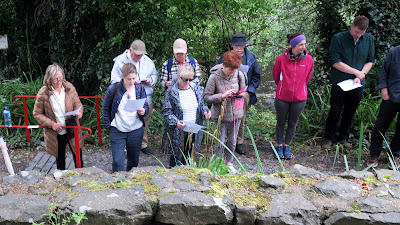Finding Brigid, missing the rain
Timing is everything, especially when a weather-perfect walk around Kilcullen's reference points for Brigid got back to the Library just before the one downpour shower of the afternoon, writes Brian Byrne. "She was looking after us," one of the some 30 participants in the Heritage Week event said as they looked out, cup of tea in hand, at the water torrenting from the heavens. Indeed it looked like she had.
The event had kicked off in the Library with Julie O'Donoghue offering a backgrounder on the kind of environment where Ireland's premier woman saint had lived. A time and place where women had very little power or control of their own destiny. Though where Brigid could have taken advantage of her family position to have a comfortable life, she decided instead to give her life to the service of God through helping others.
While in the Library, there was opportunity to see the kind of wool and linen clothing that would have been standard garb in the time of Brigid, which would have been woven on a simple loom — there was an example there loaned by the Bridge Community Weavery — and sewn with bone or metal needles.
There were also samples of bread and butter, made by Julie to medieval recipes ("The butter came out surprisingly well, but we'll say nothing about my attempt at making cheese ...").
After that all walked over to the parish church, doubly dedicated to the Sacred Heart and St Brigid, where Sean Landers spoke about the representations of the saint, on the stained glass windows at the side altar as well as on the altar itself and on the recently re-installed pulpit at the back of the church.
Moving on to St Brigid's Well in the Valley, the group sang a hymn to the saint before listening to locally-written myths and legends from the Irish Folklore Commission Schools Project of the late 1930s.
Onwards then to the Spout at the town end of the Valley where Mary Orford spoke about how it had for a long time been the main source of water for Kilcullen. And still was considered some of the best water in the area. That brought her back further to when drinking water in the time of Brigid wasn't trustworthy, so she became renowned for the ale she brewed as an alternative for both rich and poor who came for her hospitality.
The last element of the afternoon was a stop on the laneway down to the Valley where Gerry O'Donoghue provided detail of the Iron Age which was the period in which Brigid lived and worked, remarking on the remains of a brewery from that era found in excavations at Brownstown, north of Kilcullen. Then it was back to the Library for some very welcome refreshments and chat and more story exchanges.
And to look out at the cloudburst which would have been all our lot if any of the speakers had gone beyond their allotted time by as little as five minutes ...
Timing is everything.










































